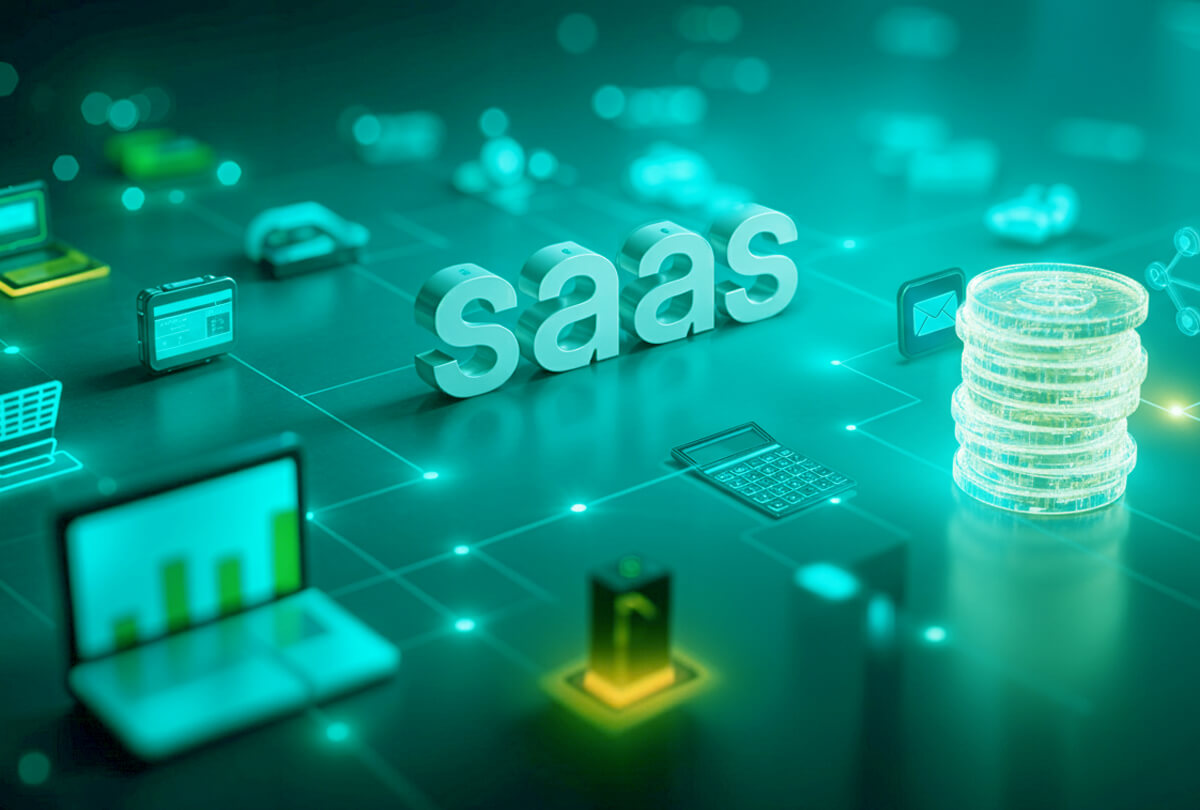B2B SaaS: Transforming Business Efficiency in the Digital Age

The B2B SaaS model has become a cornerstone for companies seeking to scale, optimize processes, and make data-driven decisions. Thanks to cloud technology, organizations gain access to flexible and up-to-date software without relying on local infrastructure, enabling them to improve collaboration, automate critical activities, and accelerate operational efficiency.
This article summarizes the essential aspects of B2B SaaS, its impact on business management, key tools, emerging trends, and the best strategies for achieving sustainable growth.
What is B2B SaaS and how does it work?
Software as a Service (SaaS) allows companies to use cloud-hosted applications through a subscription. This model offers:
- Full accessibility: access from any device, favoring hybrid teams.
- Automatic updates: ensures the availability of new features without interruption.
- Enhanced security: encryption, multi-factor authentication, and continuous audits.
- Lower implementation cost: reduces investment in hardware and maintenance.
Key features of B2B SaaS
- Flexibility and scalability: allows you to adjust capabilities and licenses according to your needs.
- Connecting teams: facilitates real-time collaboration.
- Subscription model: improves financial forecasting and allows testing tools before full adoption.
Differences between B2B and B2C within SaaS
The B2B approach differs from other models, such as B2C (Business to Consumer), in several key aspects. While B2C focuses on direct sales to the end consumer, B2B is geared towards facilitating collaboration and processes between businesses. This distinction affects how SaaS solutions are designed and marketed.
- More complex relationships: B2B transactions typically involve more complex decisions and multiple stakeholders compared to B2C relationships.
- Customized needs: B2B customers require solutions tailored to their specific needs and internal processes.
- Contract duration: In B2B, agreements are usually long-term, which implies a more strategic approach to the customer relationship.
Main SaaS tools and applications for businesses
B2B SaaS solutions cover virtually all business processes. Among the most relevant categories are:
CRM for customer and sales management
B2B CRMs allow you to centralize account information, automate sales processes, and improve the conversion of leads into actual opportunities. Their advanced features include:
- Tracking interactions, pipeline, and lead activity.
- Audience segmentation and predictive analytics.
- Integration with automation and ERP tools.
Software for project management and productivity
Project management tools enhance efficiency by:
- Kanban boards, task assignment and deadline control.
- Cross-departmental collaboration.
- Real-time metrics on progress and workload.

Marketing automation and digital campaigns
Marketing automation is becoming a crucial tool for businesses looking to optimize their campaigns. These solutions allow companies to schedule tasks, analyze results, and segment audiences, improving the effectiveness of their marketing strategies. Automation platforms enable the execution of comprehensive strategies:
- Automated sending of segmented emails.
- Coordinated management of social media and paid campaigns.
- Lead nurturing with behavior-based workflows.
These tools are essential for scaling the acquisition funnel and nurturing leads into SQLs.
Solutions for financial management and ERP
Financial management solutions are another essential component within the SaaS environment. They help companies maintain rigorous control over their financial resources and better plan for their future needs. SaaS-based ERPs help to:
- Control accounting, invoicing and reporting.
- Reduce errors and save time with automation.
- Unify cross-functional information between areas.
Integration and security: pillars of modern SaaS
Integration and security are fundamental aspects of SaaS platforms, as they determine the operational efficiency and data protection of organizations. These elements offer confidence and convenience to companies that adopt these solutions. The ability to integrate with the company’s digital ecosystem is one of the most decisive factors when choosing a B2B SaaS.
Integration with existing systems
Integrating SaaS platforms with existing business systems is a priority for organizations seeking to maximize efficiency. Integration capabilities allow different applications to work synergistically, facilitating a seamless flow of information. APIs enable SaaS to connect with:
- CRM
- Marketing platforms
- Human resources systems
- ERPs
- Internal applications
This reduces duplicate tasks, improves information flow, and speeds up decision-making.
Security and regulatory compliance
Data security is a critical aspect of the SaaS environment, as companies handle sensitive and confidential information. SaaS providers implement measures such as:
- Encryption in transit and at rest
- Multi-factor authentication
- Periodic audits
- Privacy policies aligned with GDPR
Furthermore, compliance with regulations such as GDPR and HIPAA is essential for companies that handle personal data. Providers must offer guarantees that their platforms are aligned with the relevant legal requirements. Their ability to manage automatic updates ensures maximum protection without any operational burden for the client.
Emerging trends in B2B SaaS
The SaaS ecosystem is evolving rapidly, driven by technologies that are redefining the way businesses operate.
Generative AI and machine learning
Artificial intelligence (AI) and machine learning are revolutionizing access to education. These technologies are being integrated into educational management platforms to offer personalized experiences tailored to each student’s needs. AI allows for the analysis of user behavior and the prediction of their requirements, facilitating the creation of customized materials and courses.
The implementation of chatbots, for example, allows for more efficient customer service, facilitating real-time resolution of queries. These tools not only optimize the user experience but also alleviate the workload of educational staff. AI enables:
- Personalize experiences and automate decisions.
- Analyze user behavior.
- Create content, automate campaigns, and improve support.
Chatbots, for example, offer immediate assistance and reduce operational burden.
Vertical solutions and advanced customization
SaaS specialization is growing: tools are being adapted to sectors such as industry, technology, energy, construction, and professional services. This allows for the adjustment of workflows, integrations, and data models to each business operation.
IoT and real-time data
The integration of the Internet of Things (IoT) into the B2B SaaS sector is changing how data is collected and used. Connected devices allow institutions to gain real-time insights into student performance and behavior. This data collection facilitates informed decision-making regarding academic development and resource management.
On the other hand, the ability to manage this data effectively helps institutions identify areas that require attention or improvement, thus optimizing administrative processes. Thanks to connected devices, companies obtain instant information on performance, activity, and processes. This enables faster decision-making and reduces inefficiencies.
Blockchain for greater transparency
The integration of blockchain promises to increase transparency and security in data management. This decentralized system allows for more effective tracking of credentials, preventing fraud and ensuring the accuracy of information.
Furthermore, the use of smart contracts can automate administrative processes, making business operations more efficient. This allows companies to focus on improving product quality, eliminating conflicts related to data management. It enables traceability, secure data verification, document control, and the elimination of intermediaries in critical processes.
Growth strategies for B2B SaaS companies
Clear and differentiated value proposition
Growth and optimization are fundamental for software-as-a-service companies. Through various strategies, resources can be maximized and a competitive advantage secured in the market. To stand out in a competitive market, SaaS companies must:
- Show tangible and measurable benefits.
- To emphasize the importance of specialization within the sector.
- Showcase proven achievements and tangible outcomes.
Flexible pricing models
Establishing an effective pricing model is key to attracting and retaining customers. Many vendors opt for flexible pricing structures, which facilitate software adoption, including pay-as-you-go options and monthly subscriptions. The most common strategies include:
- Pay-as-you-go
- Scalable subscriptions
- Free demos
- Prices tailored to the size of the company
These formulas reduce barriers to entry and accelerate adoption. B2B SaaS providers often offer
- Training and development for staff.
- Regular software updates at no extra cost.
- Advice on the implementation of the tools and their integration with existing systems.
Regarding subscription models, most providers offer flexible options that adapt to the needs and budgets of educational institutions, allowing for better financial and administrative planning.
Customer service as a retention driver
Providing excellent customer service is fundamental for any SaaS company. Users need to feel supported and have access to technical support when they need it. Ticketing systems, live chat, and online resources, such as tutorials and FAQs, are essential for facilitating problem resolution. Proactive support that anticipates potential issues can increase customer satisfaction and loyalty.
Furthermore, ongoing training on how to use the platform leads to greater utilization of the software and a reduction in user churn. Robust support increases satisfaction and decreases churn.
- Live chat
- Knowledge base
- Centralized ticketing
- Ongoing professional development
Strategic alliances and co-marketing
Forming strategic alliances is an effective way to expand your user base. Collaborating with other companies in the SaaS or technology sector can open doors to new markets and audiences. Through integrations, co-marketing, and referral programs, synergies can be created that benefit both parties. Collaborations allow you to:
- Expand the user base.
- Increase visibility in new verticals.
- Integrate complementary solutions.
Key metrics for evaluating a B2B SaaS solution
Usage and adoption indicators
Tracking the adoption of SaaS tools is crucial for understanding how users interact with the software. Some of the most relevant indicators include:
- Frequency of use: How many times users access the platform each week or month.
- Session duration: Average time users spend in the application, indicating their level of engagement.
- Activation rate: Number of users who complete defined key actions, such as account setup or completion of an initial task.
ROI and cost savings
Evaluating return on investment (ROI) is essential to determine if B2B SaaS solutions are generating significant benefits. To do this, the following should be considered:
- Operating costs: Comparison of expenses on technology and resources with the savings achieved through automation.
- Revenue increase: How the use of the software has contributed to increased sales or improved efficiency in other key areas.
Customer satisfaction and retention
Customer satisfaction is a direct indicator of the success of a SaaS solution. It can be measured using:
- Satisfaction surveys: Periodic evaluations that allow us to know the opinion of users on various aspects of the software.
- Retention rate: Proportion of users who continue to use the application over time, a key metric that indicates customer loyalty.
Leveraging data to inform strategic decision-making.
B2B SaaS platforms generate a significant amount of data that can be leveraged for strategic decision-making. Some ways to use this data include:
- Behavioral analysis: Identifying patterns in software usage that can guide future optimizations.
- Product performance
- Usage patterns that can inform new functionalities and enhance advanced reporting: Creation of detailed reports that make it easier to visualize outcomes and long-term trends.
Why choose Sheridan for your B2B SaaS strategy
At Sheridan, we create business. Our specialization in B2B marketing and sales allows us to support SaaS companies in building comprehensive strategies for customer acquisition, automation, and growth.
We offer:
- Unified strategic vision
- Omnichannel execution
- Ongoing refinement of the conversion funnel
- Alignment between marketing and sales
- Experience in SaaS, industrial and technology sectors
We are a strategic partner, not just a marketing agency. Request your free consultation with our experts right here.



